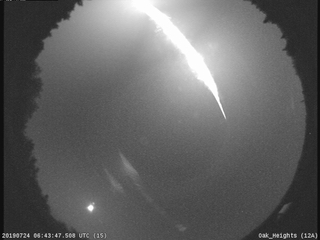Meteorites may have been dropped during a bright fireball event near Bancroft, the Western University says.

In an official statement released by the university, it stated that the Western University All-Sky Camera Network observed a fireball “as bright as the full moon” across southwestern Ontario and Quebec on Wednesday morning at 2:44 a.m. ET.
The network is constantly monitoring the sky for meteors, and Western’s Physics and Astronomy Department also runs an all-sky camera network in collaboration with NASA’s Meteoroid Environment Office at the Marshall Space Flight Center.
Peter Brown, a Western University astronomy profession who specializes in the study of meteors, confirmed that 10 all-sky cameras recorded a shiny fireball over western Ontario early Wednesday morning. Cameras in Montreal even captured the event, despite the far distance.
Researchers value events such as this one, because high-quality video data of the fireball’s passage through the atmosphere is collected, which provides further insight into where the rock originated in the solar system.

Get daily National news
The official statement states that preliminary results indicate that the fireball first became visible just south of Oshawa over Lake Ontario at an altitude of 93 kilometers. It flew over Clarington and passed just west of Peterborough before extinguishing west of Bancroft.
The fireball had bright flares towards the end of its flight, and the size of the meteoroid was comparable to a beachball; around 30 centimeters in diameter.
It’s also likely that the meteoroid dropped a small amount of meteorite fragments in the tens to hundreds of grams size-range on the ground.
The official statement says meteorites can be identified by their dark and often scalloped exterior, they will usually feel denser than most rocks, and often be attracted to magnets.
They are not dangerous, but if recovered, it’s ideal to place them in a clean plastic bag or wrap them in aluminum foil.
In order to preserve their scientific value as much as possible, it’s best to avoid handling them too much.
WATCH: (May 22, 2019) Meteor lights up Australian night sky

Brown and his collaborators at the university and the Royal Ontario Museum are calling for folks around the area of the potential fall, who may have heard anything unusual, or who may have found possible meteorites to connect with them.
The official statement states that in Canada, meteorites belong to the owner of the land upon which they are found. If individuals plan to search by exploring different lands, they should always ask for permission from the land-owner beforehand.
Those who may have found a suspicious rock that may be from this event can contact Kim Tait of the Royal Ontario Museum at ktait@rom.on.ca












Comments